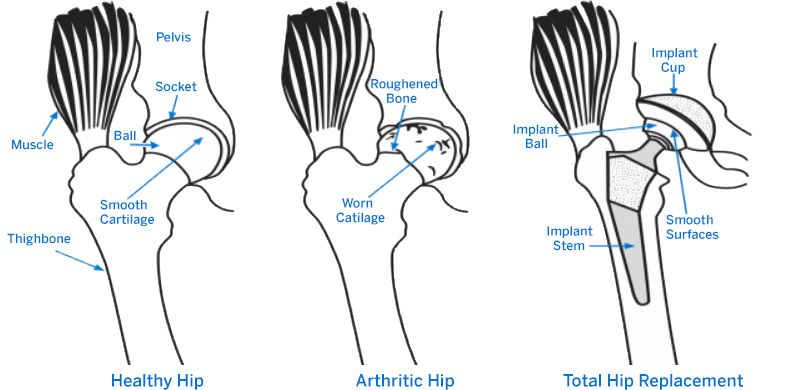Total Hip Replacement (THR) (Cemented and Cementless)
Description

A total hip replacement is a salvage procedure in which the hip joint is removed and replaced with a synthetic hip joint. Special care is taken to ensure that the surgery is done under strict aseptic conditions. The dog’s hind limb is clipped the day before the surgical procedure, the skin is evaluated for bacterial infections, and blood work and urine testing is performed prior to surgery to screen for infection. If infections are noted, the surgery must be postponed until the underlying infection has resolved in order to prevent complications with the hip implant.
Indications
THR is used to treat mature dogs with painful hip dysplasia or other advanced causes of degenerative hip disease. This procedure cannot be performed until the animal’s growth plates have closed, which usually occurs at about one year of age. In addition, there are certain size requirements that animals must meet in order to fit commercially available implants. In extreme cases of hip dysplasia or trauma to the hip, a hip replacement may not be possible due to wearing and remodeling of the bone surrounding the hip.
Postoperative Care
Pain medication is generally only required for the first three to five following surgery. Give pain medication only as prescribed and do not give human drugs without first consulting with a veterinarian.
Activity must be absolutely restricted to a kennel or a small pen with good footing for at least two months postoperatively. Early vigorous activity or falling can lead to luxation (ball popping out of the socket) of the prosthetic hip. Your pet can walk on the leg, but you should provide sling support to prevent slipping. Take your pet outside on a leash with a sling to support the hindquarters, allowing your pet to urinate or defecate and walk around for 3-5 minutes only. Do not allow running, jumping, or playing with other pets.
Please observe your pets for any of the following problems:
- Sudden increase in lameness
- Swelling or discharge from the incision
Please schedule an appointment for suture removal 7 to 10 days after surgery. In addition, please contact us immediately if any problems are noted. Another examination is recommended approximately three months post-operatively to assess healing of the hip. Long-term follow-up consists of annual examination and radiographs to monitor the hip for problems.
Prognosis
The prognosis for most dogs following hip replacement is excellent for a return to normal athletic function. Over 90% of the cases have an excellent outcome. Although they are not common, complications can be dramatic when they occur and may require additional major surgery to resolve. Such complications include luxation of the artificial hip, infection of the implants, fracture of the femur, and implant loosening. Aside from these potential complications, most of our canine patients do extremely well following hip replacement if the patient is carefully selected and the aftercare instructions are followed.
Your pet’s recovery and well-being are our primary concerns, so please do not hesitate to call and speak with a surgical technician or surgeon if there are any questions regarding your pet’s recovery.
Figure 1: https://www.hss.edu/condition-list_hip-replacement.asp
